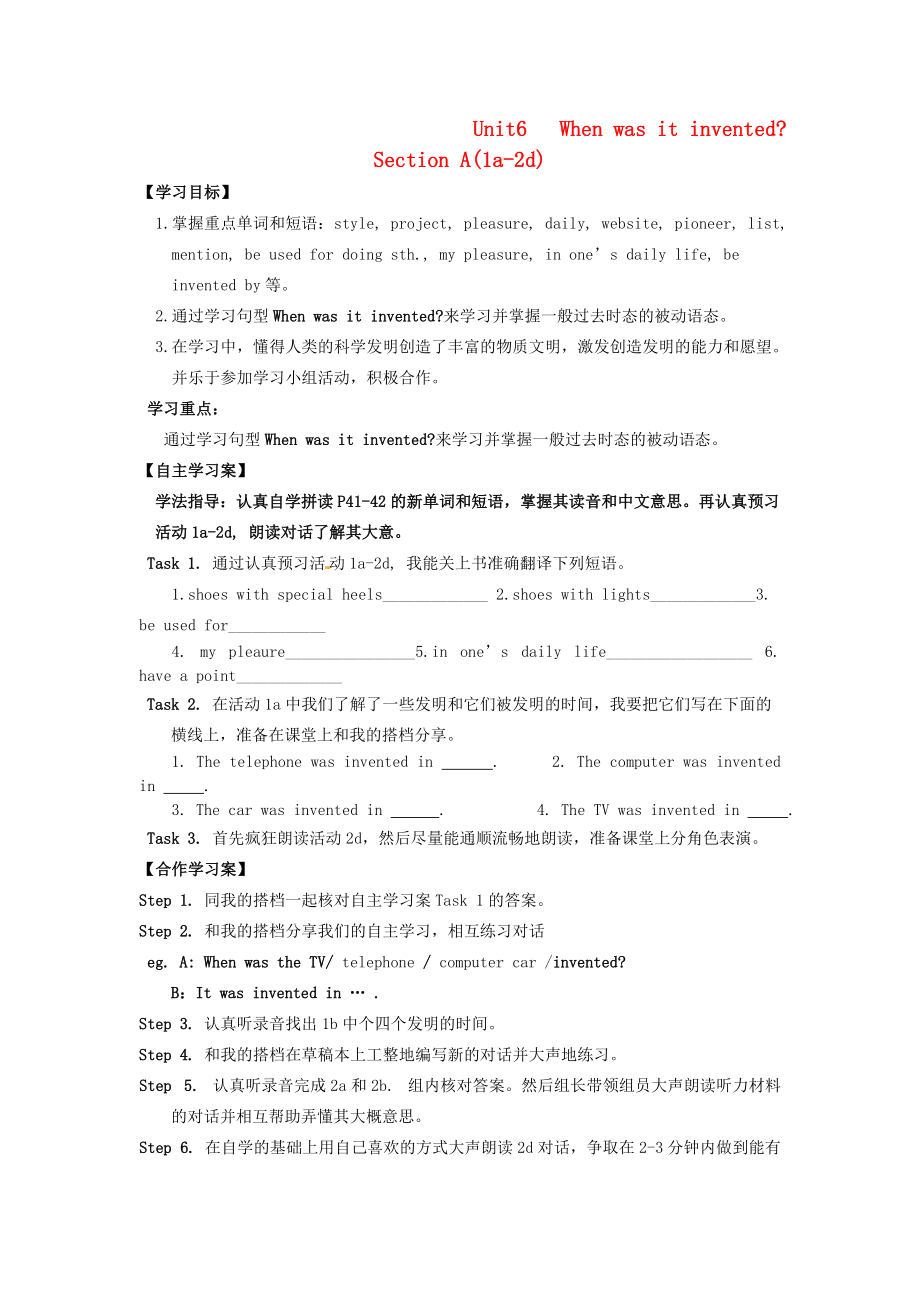《山西省運(yùn)城市垣曲縣九年級(jí)英語(yǔ)全冊(cè) Unit 6 When was it invented Section A1a2d學(xué)案無(wú)答案新版人教新目標(biāo)版》由會(huì)員分享�����,可在線閱讀,更多相關(guān)《山西省運(yùn)城市垣曲縣九年級(jí)英語(yǔ)全冊(cè) Unit 6 When was it invented Section A1a2d學(xué)案無(wú)答案新版人教新目標(biāo)版(3頁(yè)珍藏版)》請(qǐng)?jiān)谘b配圖網(wǎng)上搜索�。
1、
Unit6 When was it invented? Section A(1a-2d)
【學(xué)習(xí)目標(biāo)】
1.掌握重點(diǎn)單詞和短語(yǔ):style, project, pleasure, daily, website, pioneer, list, mention, be used for doing sth., my pleasure, in one’s daily life, be invented by等�。
2.通過(guò)學(xué)習(xí)句型When was it invented?來(lái)學(xué)習(xí)并掌握一般過(guò)去時(shí)態(tài)的被動(dòng)語(yǔ)態(tài)。
3.在學(xué)習(xí)中��,懂得人類(lèi)的科學(xué)發(fā)明創(chuàng)造了豐富的物質(zhì)文明�,激發(fā)創(chuàng)造發(fā)明
2、的能力和愿望���。并樂(lè)于參加學(xué)習(xí)小組活動(dòng)�,積極合作�。
學(xué)習(xí)重點(diǎn):
通過(guò)學(xué)習(xí)句型When was it invented?來(lái)學(xué)習(xí)并掌握一般過(guò)去時(shí)態(tài)的被動(dòng)語(yǔ)態(tài)。
【自主學(xué)習(xí)案】
學(xué)法指導(dǎo):認(rèn)真自學(xué)拼讀P41-42的新單詞和短語(yǔ)��,掌握其讀音和中文意思�����。再認(rèn)真預(yù)習(xí)活動(dòng)1a-2d, 朗讀對(duì)話了解其大意���。
Task 1. 通過(guò)認(rèn)真預(yù)習(xí)活動(dòng)1a-2d, 我能關(guān)上書(shū)準(zhǔn)確翻譯下列短語(yǔ)�����。
1. shoes with special heels_____________ 2.shoes with lights_____________3. be used for____________
4. my p
3�、leaure________________5.in one’s daily life__________________ 6. have a point_____________
Task 2. 在活動(dòng)1a中我們了解了一些發(fā)明和它們被發(fā)明的時(shí)間���,我要把它們寫(xiě)在下面的橫線上���,準(zhǔn)備在課堂上和我的搭檔分享。
1. The telephone was invented in . 2. The computer was invented in .
3. The car was invented in . 4. The TV was
4�、invented in .
Task 3. 首先瘋狂朗讀活動(dòng)2d,然后盡量能通順流暢地朗讀�,準(zhǔn)備課堂上分角色表演。
【合作學(xué)習(xí)案】
Step 1. 同我的搭檔一起核對(duì)自主學(xué)習(xí)案Task 1的答案�����。
Step 2. 和我的搭檔分享我們的自主學(xué)習(xí)���,相互練習(xí)對(duì)話
eg. A: When was the TV/ telephone / computer car /invented?
B:It was invented in … .
Step 3. 認(rèn)真聽(tīng)錄音找出1b中個(gè)四個(gè)發(fā)明的時(shí)間�。
Step 4. 和我的搭檔在草稿本上工整地編寫(xiě)新的對(duì)話并大聲地練習(xí)�����。
Step 5.
5、認(rèn)真聽(tīng)錄音完成2a和2b. 組內(nèi)核對(duì)答案��。然后組長(zhǎng)帶領(lǐng)組員大聲朗讀聽(tīng)力材料的對(duì)話并相互幫助弄懂其大概意思��。
Step 6. 在自學(xué)的基礎(chǔ)上用自己喜歡的方式大聲朗讀2d對(duì)話���,爭(zhēng)取在2-3分鐘內(nèi)做到能有感情的背誦對(duì)話���。然后小組合作弄懂對(duì)話的大概意思,勾出重點(diǎn)�����,做好隨堂筆記�。完成后由組長(zhǎng)根據(jù)行展示。
Step 7. 知識(shí)梳理��。
1.invent (v.)發(fā)明�;創(chuàng)造
invent 指發(fā)明創(chuàng)造出自然界本來(lái)不存在的東西,如工具�、方法、手段�、汽車(chē)、電器���、合成材料等�。
eg. Bell invented the telephone. 貝爾發(fā)明了電話��。
2.be used for 用來(lái)做…… 此短
6�、語(yǔ)中的for是介詞,表示用途���,后接名詞或動(dòng)詞-ing形式��。
eg. An orange is used for medicine. 桔子可以入藥��。
A pen is used for writing. 鋼筆用來(lái)寫(xiě)字�。
【橫向輻射】discover, find, create
1.discover是“發(fā)現(xiàn)”的意思�����,是指發(fā)現(xiàn)原來(lái)就有而一直沒(méi)被發(fā)現(xiàn)�����,如發(fā)現(xiàn)電�、煤、石油等礦藏及新星���、星系或科學(xué)真理等�����。
eg. Columbus discovered America in 1492.1492年哥倫布發(fā)現(xiàn)了新大陸�。
2.find的意思是“尋找”,強(qiáng)調(diào)找的結(jié)果�,并不指發(fā)現(xiàn)。
eg. Ive t
7�����、ried to find another copy but couldnt find one.我試圖再找一本�����,但沒(méi)能弄到���。
3.create指有目的地把原材料制成新產(chǎn)品�����,也指創(chuàng)造出原來(lái)不存在的或與眾不同的事物���。
eg. Man creates himself. 人類(lèi)創(chuàng)造了自己��。
【橫向輻射】be used as & be used by
1.be used as 意為“被用作……”��,介詞as表示“作為”�����,其后一般接名詞,強(qiáng)調(diào)使用的工具及手段���。
eg. English is used as the second language in many countries. 英語(yǔ)在許多國(guó)家
8�、被當(dāng)作第二語(yǔ)言使用���。
2.be used by 意為“被……使用”�,介詞by后面接動(dòng)作的執(zhí)行者(賓語(yǔ))���。
eg.English is used by travelers and business people all over the world. 全世界的旅行者和商人們使用英語(yǔ)��。
【鞏固訓(xùn)練案】
I.按要求完成下列句子���。
(1)Cars were invented in 1885.(對(duì)劃線部分提問(wèn))
cars invented?
(2 ) Julie Thompson invented electric slippers.(改為被動(dòng)語(yǔ)態(tài))
9、 Electric slippers Julie Thompson.
(3) The shoes with lights are used for seeing in the dark.( 對(duì)劃線部分提問(wèn))
are the shoes with lights ?
(4) The light bulb(燈泡) was invented by Thomas Edison. (對(duì)劃線部分提問(wèn))
the light bulb invented by?
(5)Th
10、e refrigerator is used to keep food fresh.(改為同義句)
The refrigerator is used food fresh.
II. 根據(jù)漢語(yǔ)意思完成句子�。(一空一詞)
1. 電腦是這樣偉大的發(fā)明,以致極大地改變了世界��。
Computer is a great that it has changed the world a lot.
2. 想想電腦在我們?nèi)粘I钪杏玫枚嗝搭l繁��。
Think about how the computer is
11�、 our lives.
3. 你可以列出你的工作項(xiàng)目。You can your work .
4. –你能幫我看看那鞋子的款式嗎���? --沒(méi)問(wèn)題��。
-- Can you help me look at the of the shoes?
-- .
5. 沒(méi)有提到那是被誰(shuí)發(fā)明的���。
It doesn’t who it .
【總結(jié)反思】
這節(jié)課我學(xué)到的新知識(shí)有:___________________ ___________________________________
這節(jié)課我的不足之處是:
6EDBC3191F2351DD815FF33D4435F3756EDBC3191F2351DD815FF33D4435F3756EDBC3191F2351DD815FF33D4435F3756EDBC3191F2351DD815FF33D4435F3756EDBC3191F2351DD815FF33D4435F3756EDBC3191F2351DD815FF33D4435F375
 山西省運(yùn)城市垣曲縣九年級(jí)英語(yǔ)全冊(cè) Unit 6 When was it invented Section A1a2d學(xué)案無(wú)答案新版人教新目標(biāo)版
山西省運(yùn)城市垣曲縣九年級(jí)英語(yǔ)全冊(cè) Unit 6 When was it invented Section A1a2d學(xué)案無(wú)答案新版人教新目標(biāo)版

